Did you know a single telecom tower rollout can involve over 1,500 decisions - from zoning laws to antenna angles? Now, imagine optimizing that chaos with AI.
If you’ve been wondering how can AI support telecom network rollouts, you’re about to see how data-driven intelligence is turning delay-prone deployments into precision-executed operations across the globe.
In this article, we will explore:
- Speed up rollouts using six AI-powered strategies
- See how top telecom leaders succeed with AI
- Overcome key challenges slowing AI integration
Accelerate Your Network Rollouts: 6 AI Strategies Transforming Telecom Deployments
The telecom industry is experiencing a revolutionary transformation through artificial intelligence. Modern AI systems are eliminating traditional deployment bottlenecks, reducing rollout timelines significantly while dramatically improving network performance and cost efficiency.
1. AI in Site Selection & Planning
Intelligent algorithms revolutionize how telecom operators identify and evaluate potential network sites, replacing months of manual analysis with rapid, data-driven insights.
AI transforms site selection through:
- Geographic analysis processing terrain, demographics, and infrastructure data
- Demand forecasting, predicting traffic patterns, and capacity requirements
- Regulatory compliance checking zoning laws and permit requirements automatically
- Environmental impact assessment using satellite imagery and sensor data
Advanced machine learning models analyze thousands of variables simultaneously - from population density and traffic patterns to environmental conditions and regulatory constraints.
These systems can evaluate potential sites rapidly rather than through lengthy manual processes, identifying optimal locations that maximize coverage while minimizing infrastructure costs. Predictive demand modeling ensures networks are built where they're needed most, preventing costly over-provisioning in low-demand areas.
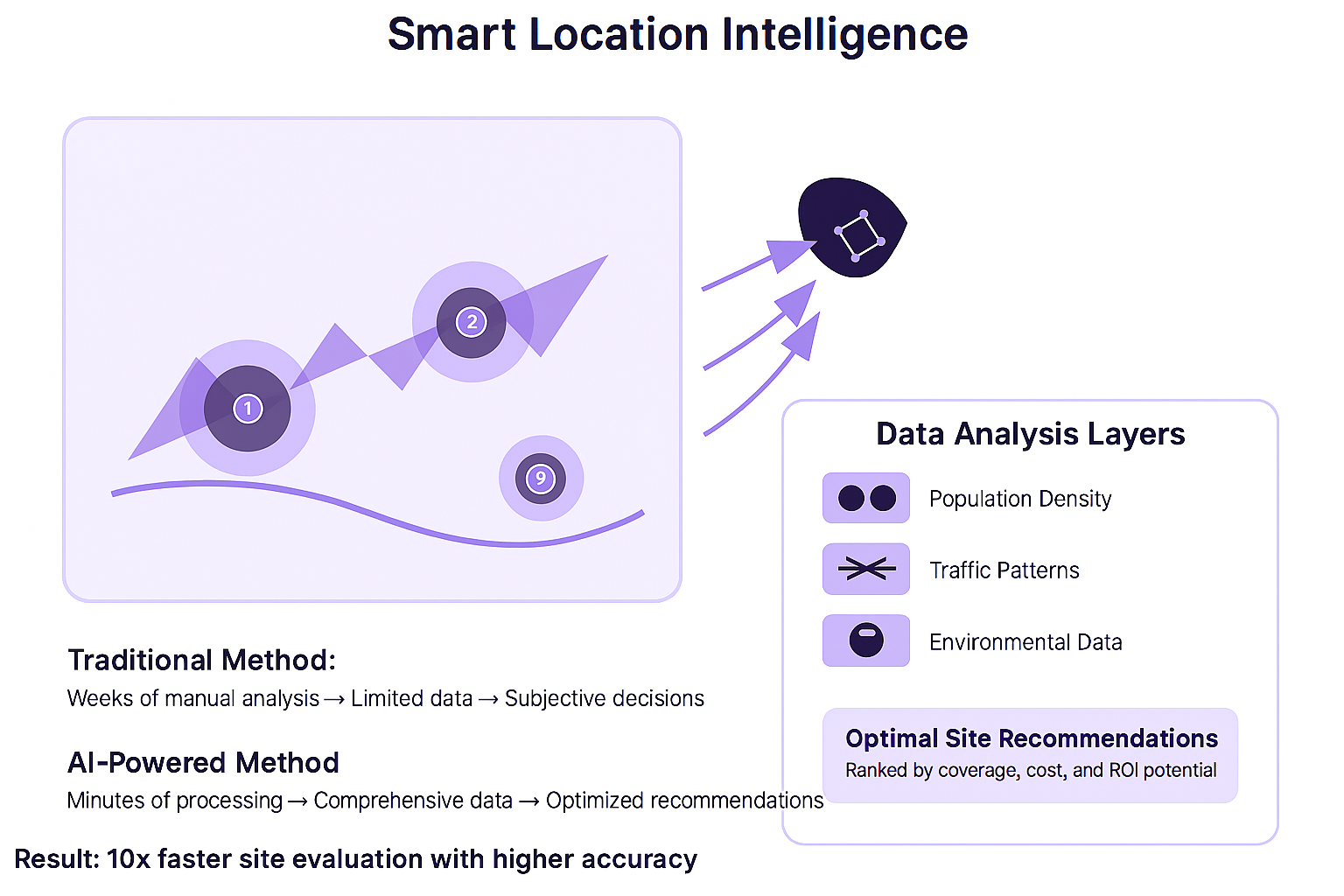
2. AI-Powered Network Design
Smart design algorithms optimize every aspect of network architecture, ensuring maximum performance with minimal resource investment.
Key design optimizations include:
- Cell tower placement using 3D modeling and coverage prediction
- Radio resource management optimizing frequency allocation and power levels
- Antenna configuration determining optimal tilt, azimuth, and height settings
- Interference mitigation, preventing signal conflicts before deployment
AI-driven design tools create virtual network models that simulate real-world performance across multiple scenarios. These systems optimize antenna configurations for maximum coverage while minimizing interference, ensuring seamless connectivity across diverse geographic conditions.
Automated frequency planning prevents signal conflicts that could degrade network performance, while power optimization delivers significant energy savings compared to traditional methods.
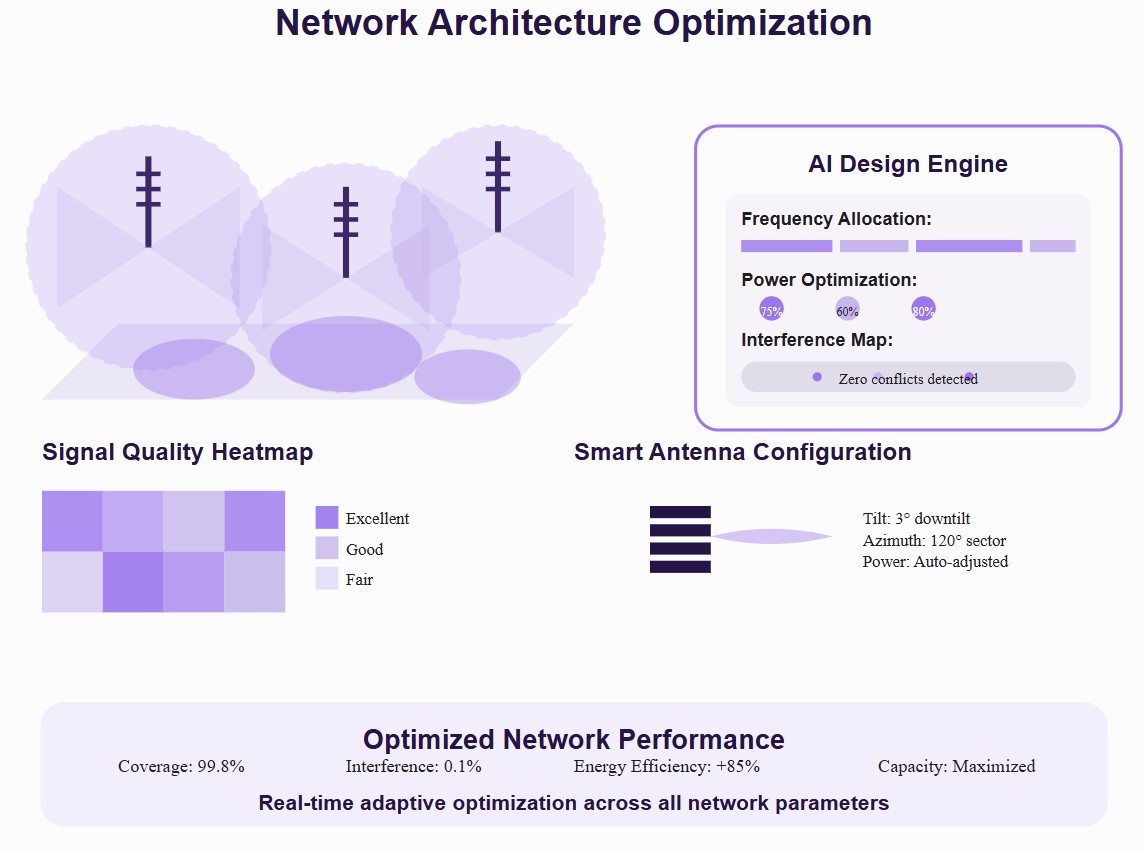
3. Predictive Rollout Scheduling
Intelligent scheduling systems coordinate complex deployment projects, optimizing timelines and resource allocation for maximum efficiency.
AI scheduling capabilities:
- Project timeline modeling considering weather, permits, and resource availability
- Workforce optimization matching skills with project requirements
- Equipment logistics, coordinating delivery and installation schedules
- Risk assessment identifies potential delays and mitigation strategies
Machine learning algorithms analyze historical deployment data to predict project timelines more accurately, identifying potential bottlenecks, which can be pre-mapped using a project dependencies template.
Dynamic scheduling automatically adjusts plans based on real-time conditions, weather delays, permit approvals, or equipment availability, ensuring projects maintain momentum. Resource optimization ensures the right technicians with appropriate skills are deployed where needed most, reducing idle time and improving productivity.
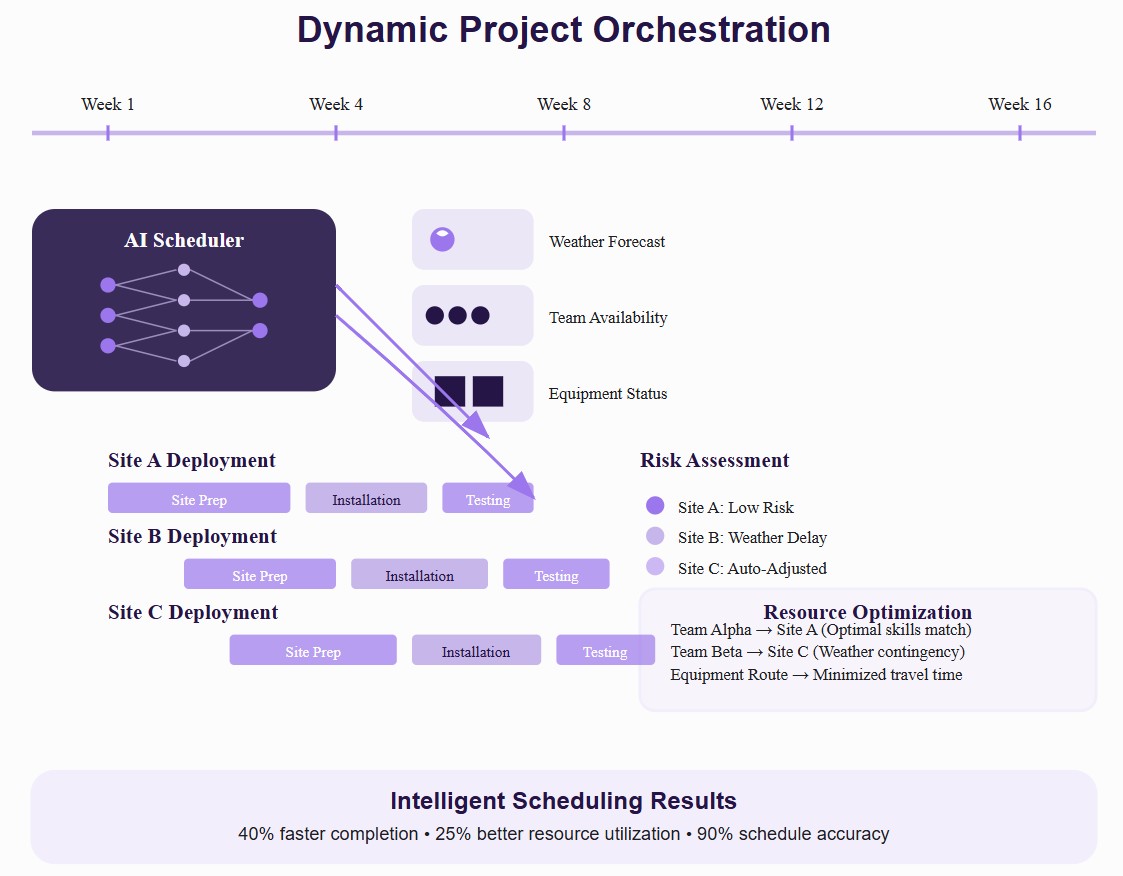
4. Real-Time Monitoring During Deployment
Advanced monitoring systems provide unprecedented visibility into deployment progress, ensuring quality and safety throughout the rollout process.
Monitoring technologies include:
- Computer vision for automated quality inspection and progress tracking
- Drone surveillance provides aerial views of installation sites
- IoT sensors monitor equipment performance and environmental conditions
- Anomaly detection identifies potential issues before they become problems
Computer vision systems automatically inspect installation quality, comparing actual work against design specifications and flagging deviations in real-time.
Drone surveillance provides comprehensive site monitoring, tracking progress, and identifying safety hazards without requiring personnel on-site. IoT sensors continuously monitor equipment performance during installation, ensuring optimal configuration from the moment systems go live.
AI-powered anomaly detection identifies unusual patterns that might indicate installation errors or equipment malfunctions.
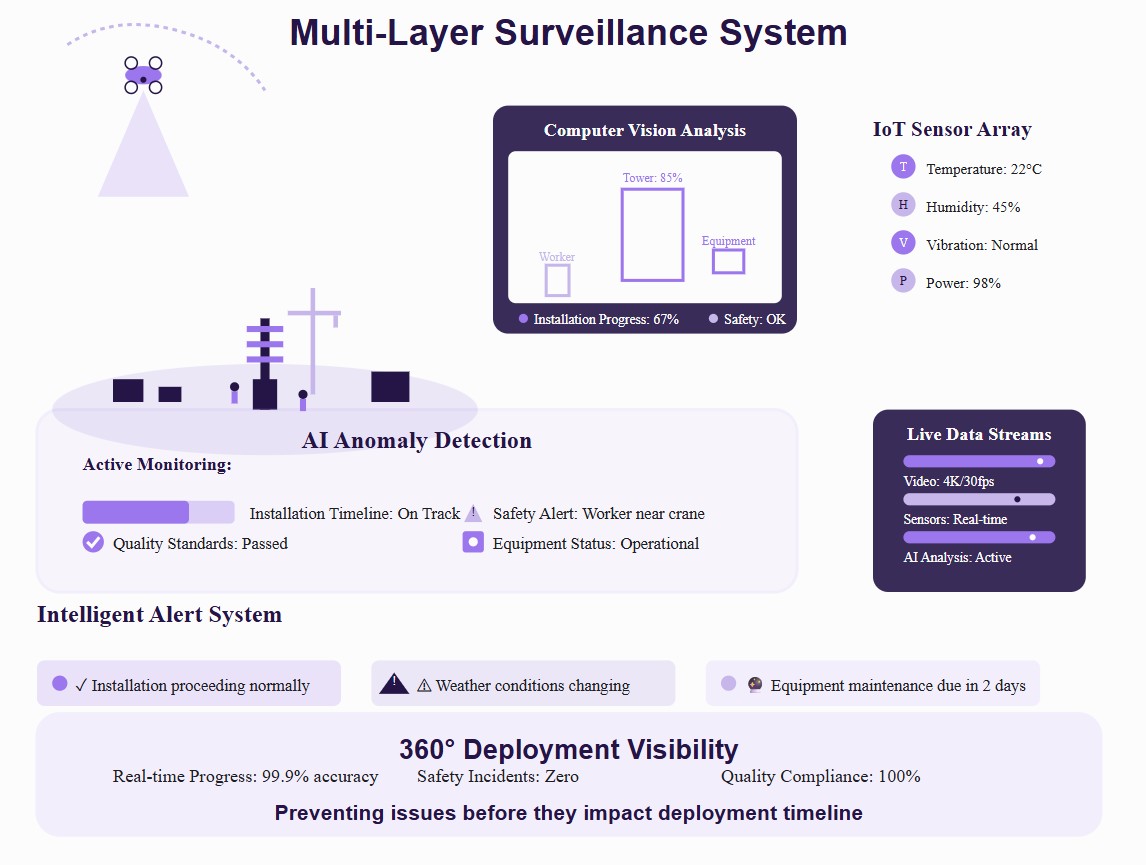
5. Post-Rollout Optimization
Continuous AI optimization ensures networks perform at peak efficiency long after initial deployment, adapting to changing conditions and demands.
Optimization capabilities:
- Performance monitoring, tracking network KPIs, and user experience metrics
- Auto-scaling adjusts capacity based on real-time demand
- Predictive maintenance prevents equipment failures before they occur
- Traffic management, optimizing data flow, and reducing congestion
AI monitoring systems track hundreds of performance metrics simultaneously, identifying optimization opportunities that human operators might miss. Automated scaling adjusts network capacity in real-time, ensuring consistent performance during peak usage periods while reducing operational costs during low-demand times.
Predictive maintenance algorithms analyze equipment health data to schedule maintenance before failures occur, significantly reducing unplanned downtime events.
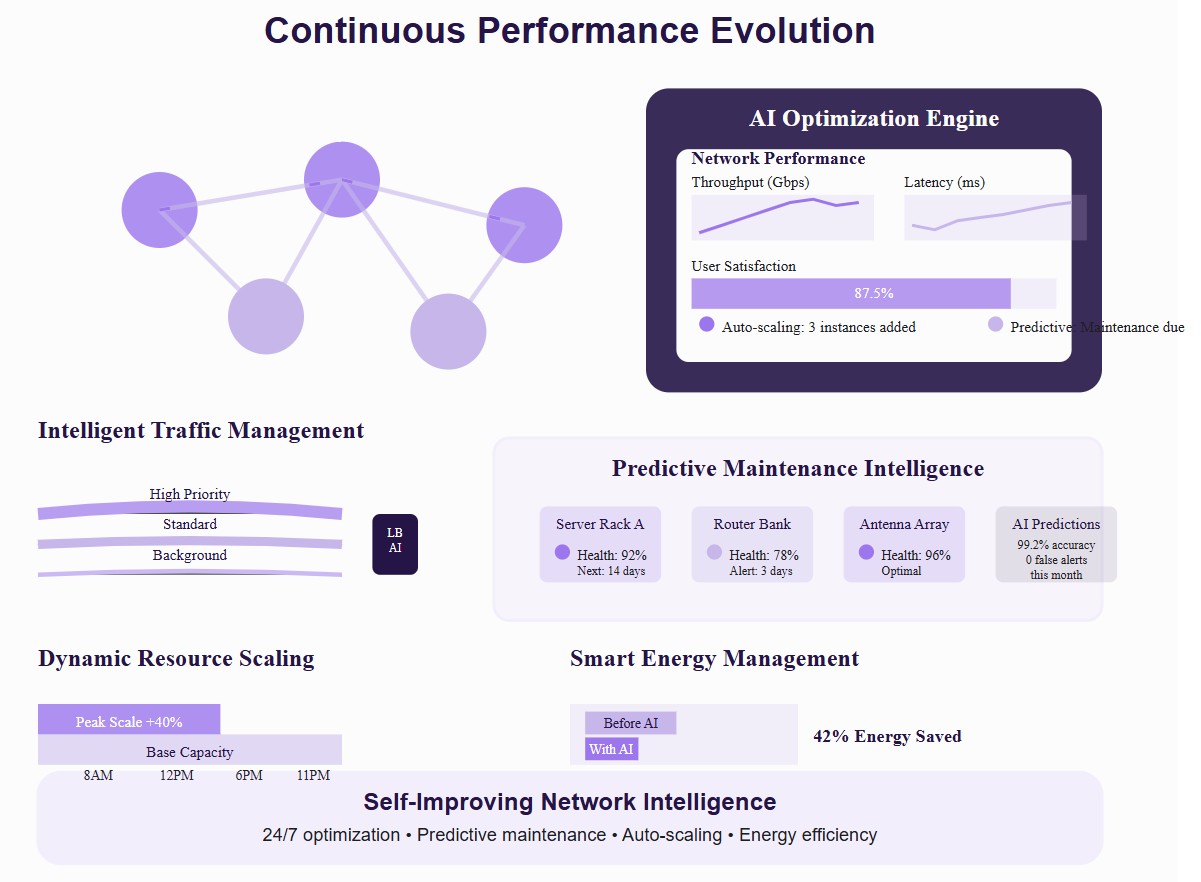
6. Cost Reduction & Faster Time-to-Market
AI-powered rollouts deliver measurable business impact through improvements in deployment speed, cost efficiency, and network performance.
Verified industry benefits include:
- Up to 90% reduction in pre-deployment preparation time
- 2-5 times more power savings with AI energy management systems
- 30% operational cost savings targeted by major operators
- Significant reduction in unplanned maintenance events
Automated processes eliminate manual tasks that traditionally consume weeks of engineering time, allowing operators to deploy networks substantially faster than conventional methods. Optimized resource allocation reduces equipment over-provisioning, while predictive maintenance prevents costly emergency repairs.
Improved site selection reduces the need for expensive infrastructure modifications, and automated quality control minimizes rework that can delay project completion.
Organizations embracing AI-powered network rollouts gain significant competitive advantages through faster deployments, lower costs, and superior network performance.
Proven Results: How Global Telecom Leaders Are Winning with AI
AI isn't just a theory in telecom; it's delivering measurable results across the globe. From 90% cost reductions to 84% efficiency gains, leading operators are proving that AI-powered rollouts deliver real business value.
🇺🇸 Verizon: Network Alpha Factory Platform
The Challenge: Migrating customers from legacy networks to next-generation infrastructure
AI Solution: Network Alpha Factory automation platform combining robotic process automation, data engineering, and machine learning
What We Know:
- Platform launched in December 2021
- Built by 50-60 IT staff in under one year
- Won 2023 US CIO 100 Award for IT innovation and leadership
- Compatible with all legacy Verizon networks
- Facilitates migration to 5G, Cloud Connectivity, and Fixed Wireless Access
Key Innovation: Seamless movement of traffic from older networks to newer, high-efficiency networks with minimal disruption
Strategic Focus: Platform designed to handle enterprise migrations and support Verizon's nationwide 5G deployment, a transition often guided by a detailed cloud migration project plan template to avoid misalignment and delays.
🇺🇸 AT&T: Comprehensive AI Integration
The Challenge: Optimizing operations across massive telecommunications infrastructure
AI Solution: Multi-faceted AI deployment including partnerships with NVIDIA and Microsoft
What We Know:
- "Ask AT&T" generative AI tool deployed for employees
- Partnership with NVIDIA for AI-powered operations optimization
- Uses NVIDIA cuOpt for dispatch optimization combining local search algorithms
- Over 1,000 AI use cases currently in development
- Rigorous governance process with privacy, legal, compliance, security, and data teams
Key Technologies:
- NVIDIA RAPIDS Accelerator for Apache Spark
- NVIDIA Triton Inference Server for real-time processing
- OpenAI's ChatGPT functionality (via Microsoft Azure)
Strategic Approach: Extremely careful vetting process where use cases can take months to approve
🇩🇪 Deutsche Telekom: AI-Powered Customer Service
The Challenge: Delivering personalized service across multiple European markets
AI Solution: Comprehensive AI assistant ecosystem and network optimization tools
What We Know:
- "Frag Magenta" chatbot serves as central customer service gateway
- Available via website, MeinMagenta app, and service hotline
- Uses Rasa's Natural Language Understanding
- More than one-third of inquiries resolved immediately without human intervention
- Processes almost one million customer inquiries annually by mail
- "Sherloq" AI evaluates documents and forwards to appropriate departments
Innovation Highlights:
- T-Duplex system understands different speaking patterns
- Family of digital human assistants (Selena, Max, Pia)
- AI-powered T-Car for network planning and fiber rollout optimization
Market Recognition: ComputerBILD named Frag Magenta the best service bot on German market
🇨🇳 China Mobile: Autonomous Network Initiative
The Challenge: Operating world's largest 5G network efficiently
AI Solution: "Jiutian" AI platform with autonomous network methodology
What We Know:
- "Jiutian" AI platform for network automation and optimization
- 500,000 5G base stations deployed (world's largest standalone core network)
- Green 5G network covering 216km shoreline and 23,000 sq km ocean area
- Uses 100% wind power for offshore network infrastructure
- 153 5G base stations and eight integrated dynamic beam base stations in ocean network
Environmental Achievement:
- Zero-carbon network using wind turbine towers and subsea fiber cables
- Network extends 5G coverage up to 50km from shoreline
- Partnership with multiple wind power companies
Scale Leadership: Operates in a challenging maritime environment with 159 typhoons in the past decade
Navigating the Roadblocks: Real AI Challenges in Telecom Rollouts
While AI promises transformational benefits for telecom rollouts, successful implementation isn't guaranteed. Here are the five critical roadblocks and proven solutions to navigate them successfully.

Data Silos and Legacy Infrastructure Compatibility
The Problem: Your existing systems weren't built for AI integration. Fragmented data sources and incompatible formats create compatibility nightmares, with 60-70% of AI budgets going toward integration rather than technology.
Solutions:
- Conduct comprehensive data audit to map existing sources and quality levels
- Implement API-first architecture for standardized interfaces between systems
- Use hybrid integration platforms as translators between legacy and modern tech
- Phase infrastructure modernization gradually rather than wholesale replacement
AI Bias and Explainability Concerns in Critical Planning
The Problem: AI decisions affect millions of customers and dollars. Site selection bias and "black box" decisions create regulatory risks and potential digital divides that can trigger investigations.
Solutions:
- Deploy explainable AI (XAI) frameworks that provide clear decision reasoning
- Establish bias detection protocols to audit outputs for discriminatory patterns
- Maintain diverse training datasets across all service areas and demographics
- Require human oversight for critical decisions with documented approval trails
Need for Cross-Functional AI-Literate Teams
The Problem: Traditional telecom expertise isn't enough for AI rollouts. The dual skills gap means telecom experts lack AI knowledge while AI specialists don't understand telecom complexity. 67% of AI projects fail without proper alignment.
Solutions:
- Invest in comprehensive training programs to upskill existing telecom staff
- Hire hybrid professionals with both telecom and AI backgrounds
- Create centers of excellence with dedicated AI teams supporting departments
- Partner with universities for telecommunications AI programs and talent pipeline
Cost and Complexity of Initial Setup
The Problem: AI costs often exceed budgets by 200-300% due to hidden complexities. Budget breakdown: 40% data prep, 25% technology, 20% training, 15% integration. Each additional system doubles complexity.
Solutions:
- Start with pilot projects to prove value before major investments
- Choose cloud-native solutions to reduce infrastructure upgrade requirements
- Prioritize high-impact use cases that deliver immediate ROI
- Plan for total cost of ownership, including maintenance, not just licensing
- Negotiate flexible vendor terms to avoid large upfront commitments
Vendor Lock-in Risks with Proprietary AI Tools
The Problem: Proprietary AI solutions create dangerous dependencies through custom formats, non-transferable models, and vendor-specific APIs. This can increase costs by 40-60% over five years while limiting innovation.
Solutions:
- Prioritize open standards and industry-standard formats for all data
- Ensure data portability with information exportable in standard formats
- Use vendor-agnostic platforms that work with multiple AI providers
- Negotiate exit clauses, including data portability and transition support
- Diversify AI portfolio across multiple vendors to avoid single dependencies
Smarter Rollouts Start With Smarter Intelligence
Telecom rollouts are becoming faster, sharper, and more cost-efficient - thanks to AI’s role in site planning, network design, real-time monitoring, and predictive optimization.
From reducing pre-deployment time by 90% to improving uptime and lowering operational costs, AI is driving measurable impact across the industry. Leading operators have already proven what’s possible. Now’s the time to rethink your rollout strategy and let data-driven intelligence lead the way.


.png)
_light%201.png)





